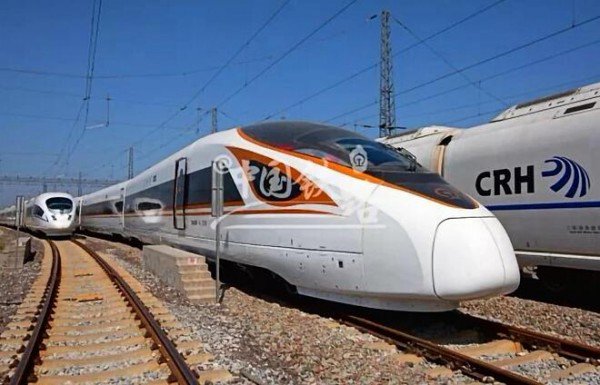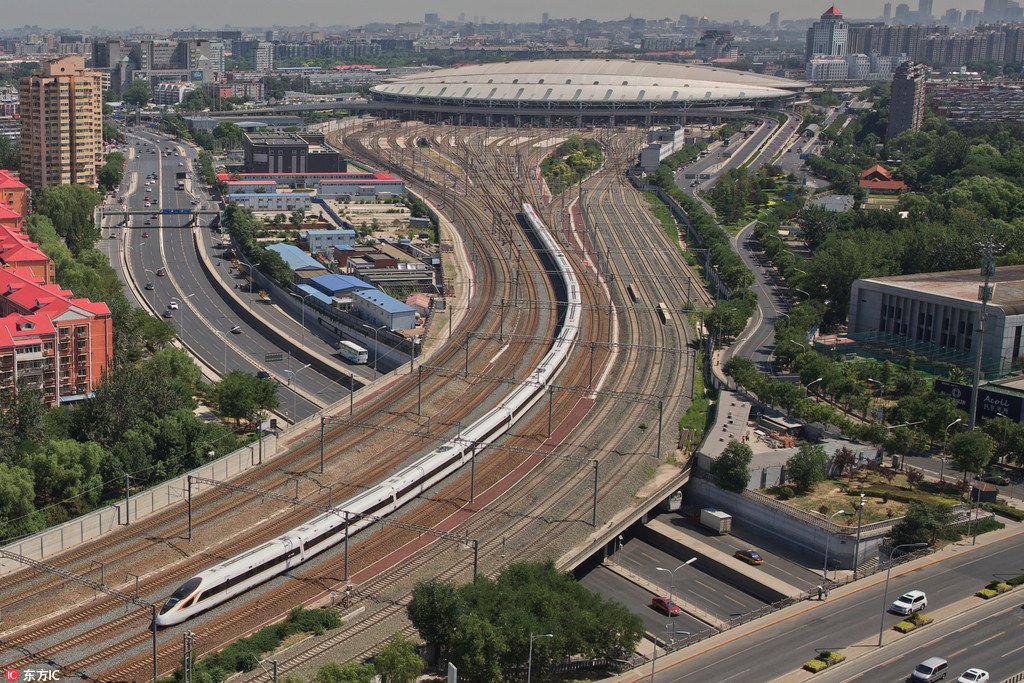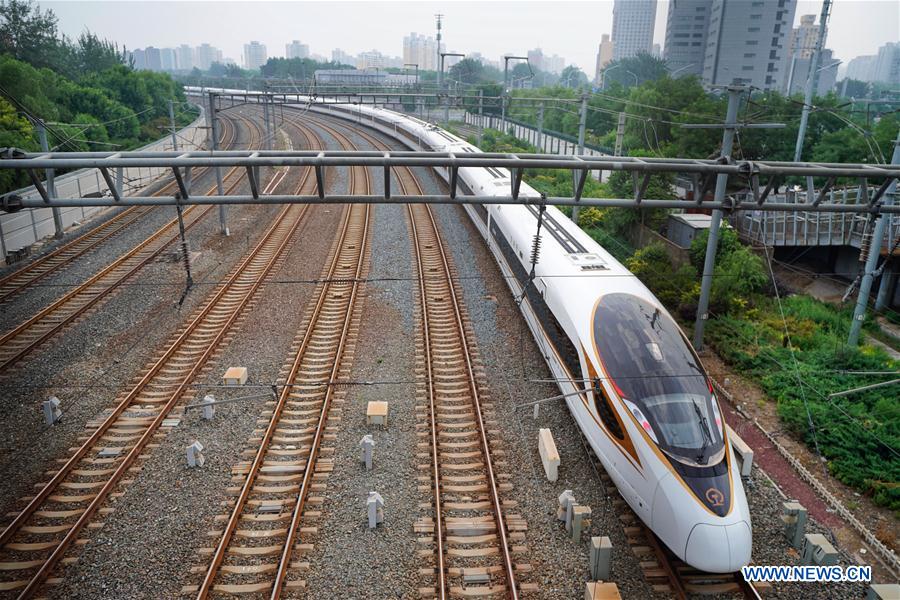You are using an out of date browser. It may not display this or other websites correctly.
You should upgrade or use an alternative browser.
You should upgrade or use an alternative browser.
News on China's scientific and technological development.
- Thread starter Quickie
- Start date
Jura The idiot
General
Yesterday at 10:18 AM
World's largest high-speed rail leaves on Sunday from Beijing for Shanghai. The 414.26-meter-long train can carry 1,193 passengers on full load, doubling the number of previous

while nowJun 8, 2018now
China's new and longer bullet train ran the first trial operation on the Beijing–Shanghai railway on Fri, undergoing final tests on 28 major functions, including tractability, braking, network communication and aerodynamic performance, before official operation on July 1.


World's largest high-speed rail leaves on Sunday from Beijing for Shanghai. The 414.26-meter-long train can carry 1,193 passengers on full load, doubling the number of previous

Hendrik_2000
Lieutenant General
Jura The idiot
General
Today at 1:25 PM
1318/(4+28/60) is 295 km per hour!
I took a closer look now as today I had been on some express train here, did in 4 hod 18 min (arrived on time) the distance of 403 km
at the Chinese speed it would had taken (403/295)*60, about 82 minutes LOL!

New longer Fuxing bullet train makes its debut
and I think it was this one ():Yesterday at 10:18 AMwhile now
World's largest high-speed rail leaves on Sunday from Beijing for Shanghai. The 414.26-meter-long train can carry 1,193 passengers on full load, doubling the number of previous

- G7
10:00Beijing South
14:28 Shanghai Hongqiao
4h28m
1318/(4+28/60) is 295 km per hour!
I took a closer look now as today I had been on some express train here, did in 4 hod 18 min (arrived on time) the distance of 403 km
at the Chinese speed it would had taken (403/295)*60, about 82 minutes LOL!

the picture comes fromThe G7 Fuxing bullet train prepares to head for Shanghai at the Beijing South Railway Station in Beijing, capital of China, July 1, 2018. The new longer Fuxing bullet train ran on the Beijing-Shanghai line for the first time on Sunday. With a designed speed of 350 kilometers per hour, the new train measures more than 400 meters in length and has 16 carriages, twice as many as current ones. It can carry nearly 1,200 passengers. (Xinhua/Xing Guangli)
New longer Fuxing bullet train makes its debut
Jura The idiot
General
now I read
China to develop new series of carrier rockets: expert
Xinhua| 2018-07-02 14:49:35
China to develop new series of carrier rockets: expert
Xinhua| 2018-07-02 14:49:35
China aims to develop a new series of small, medium, large and heavy-lift Long March carrier rockets by 2030 to meet the demands of its space operations, according to an expert.
The capacity of Chinese rockets would reach 140 tonnes for low-Earth orbit, 44 tonnes for Earth-Mars transfer orbit, 50 tonnes for Earth-Moon transfer orbit and 66 tonnes for geosynchronous transfer orbit in 2030, said Long Lehao, an academician of the Chinese Academy of Engineering and a chief designer at the China Academy of Launch Vehicle Technology, when delivering a speech in Tsinghua University.
One of the new generation rockets would be the heavy-lift Long March-9. The rocket would have a core stage with a diameter of 10 meters, and four boosters with a diameter up to 5 meters.
The takeoff weight of the 93-meter-high Long March-9 would exceed 4,000 tonnes, and its takeoff thrust would be close to 6,000 tonnes. The rocket would be able to carry a payload of 140 tonnes into low-Earth orbit, Long said.
The Long March-9 would have two variants: one with two boosters and the other one with no booster.
Some breakthroughs had been achieved on the technologies of the Long March-9.
It could be used in manned lunar landings, deep space exploration and constructing a space-based solar power plant, Long said.
China is also developing reusable space rocket, the Long March-8, which is expected to make its maiden flight around 2021. It will have two stages and two boosters. The first stage and boosters are expected to be retrieved through vertical landing, said Long.
A variant, the Long March-8A will be equipped with two larger boosters and an upper stage.
China has developed more than 10 types of carrier rockets, sending more than 400 spacecrafts into space, including more than 60 commercial satellite launches for over 20 countries. The success rate and the orbit injection accuracy are among the world's highest.
Hendrik_2000
Lieutenant General
Via Andrew Jin
Two high-speed railways open on July 1st
One in Southwest China's Yunnan Province: Kunming-Dali HSR
One in South China's Guangdong Province: Shenzhen-Zhanjiang HSR
Now, we can take bullet trains to one of China's most iconic tourist sites,
Dali ancient town by the heavenly Erhai Lake!
Say goodbye to the 5-hour coach or slow train
Now less than 2 hours!!!


Two new lines marked in the newest version of Chinese HSR network
now more than 25000km in length

Two high-speed railways open on July 1st
One in Southwest China's Yunnan Province: Kunming-Dali HSR
One in South China's Guangdong Province: Shenzhen-Zhanjiang HSR
Now, we can take bullet trains to one of China's most iconic tourist sites,
Dali ancient town by the heavenly Erhai Lake!
Say goodbye to the 5-hour coach or slow train
Now less than 2 hours!!!
Two new lines marked in the newest version of Chinese HSR network
now more than 25000km in length
solarz
Brigadier
beat elite human doctors in diagnosing brain tumors and predicting hematoma expansion in Beijing on Sat, making 87% correct diagnoses in 225 cases within 15 minutes, while 15 senior Chinese doctors achieved 66% accuracy

What would be more interesting would be the accuracy of a combined AI first, doctors second diagnosis. Would it have higher or lower accuracy than AI alone?
Hendrik_2000
Lieutenant General
It is this kind of daring risk taking and planning for the long term that make Chinese tech company hard to beat trade war or not. Instead of buying back share and distributing as dividend most Chinese company plow back the profit into buying startup or expanding overseas
China VC has overtaken Silicon Valley, but do aggregate numbers tell the whole story?
Danny Crichton,TechCrunch 1 hour 37 minutes ago

# The evidence is increasingly clear: 2018 is the year of the Chinese venture deal
The evidence is increasingly clear: 2018 is the year of the Chinese venture deal.
With half of the year now complete, China is driving ahead of Silicon Valley and the rest of the United States on venture capital dollars invested into startups, according to a number of data sources including , , and Pitchbook.
These sorts of top line numbers are always driven by large deals, and the Chinese VC market is no exception. Monster rounds this year have included , a truck hailing startup formed from , Yumanman and Huochebang, as well as Ant Financial, .
While China hasn’t overtaken the U.S. in terms of total VC rounds, it has seen spectacular growth in deal volume. Crunchbase’s analysis shows an almost four-fold increase in the number of venture capital rounds completed last quarter in China compared to the same quarter last year. That’s in comparison to a dismal seed funding market in Silicon Valley, , down by 60% or more by some estimates.
That’s a rather linear look, though, of an industry that is facing extreme flux. Venture capital today is being wholly redefined by new crowdsourcing models and of course, the rise of blockchain and the world of Initial Coin Offerings (ICOs). On the latter, billions of dollars have been raised by blockchain projects, perhaps most notoriously in recent weeks by and . Institutional capital still matters, but it isn’t the sole source of funding anymore, even at the growth stage. That makes VC aggregate data much less compelling than it might have been in the past.
However, what these aggregates do show is the changing power dynamics between the U.S. and China, particularly in critical future growth markets in the emerging world.
Nowhere is that more obvious than in the burgeoning strength of China’s high-flying tech companies. While venture firms are of course widely present in China, it is the country’s largest tech companies that are driving much of the venture investment in the mainland ecosystem. , “Tencent, Alibaba and Baidu … ranked as the first, fourth and eighth most active investors in [April], inking 11, 5 and 4 deals respectively.”
The aggressive investment strategies of Chinese tech firms was recently . In his analysis, Moritz wrote, “Between 2015 and 2017, the five biggest US tech groups (especially Apple and Microsoft) spent $228bn on stock buybacks and dividends, Bloomberg data shows. During the same period, the top five Chinese tech companies spent just $10.7bn and ploughed the rest of their excess cash into investments that broaden their footprint and influence.“
Context can explain some of this behavior, but there is also an outlook difference across the Pacific that is important to appreciate. American venture firms are robust, and Google and other tech companies don’t feel as compelled as their Chinese counterparts to step into the game themselves in order to finance the innovation industry.
Yet, one can’t help but feel that a different concept of ambition is being adopted by American companies — one that looks internally for growth rather than externally in new markets.
That’s certainly not the case in China, where companies are looking in both directions. Moritz again: “Most Chinese activity is outside the US, with Tencent and Alibaba building vast constellations of satellites. Tencent has more than 600 investments, while Alibaba has around 400 — totals that almost make Japan’s SoftBank look like a penny-pinching slowpoke.”
Meanwhile, in the United States, we see a complete pull back from much of the emerging world. is just the latest example of this myopia.
The old line about venture capitalists still holds true: most don’t want to invest more than 40 miles from their house. While many Silicon Valley-based VCs have since extended that geography to the rest of the United States, only an extraordinary few have invested in more than a handful of companies in the developing world. That has left open opportunities for investment in countries like Indonesia, Nigeria, and Brazil, where the next set of internet users are coming online.
For founders, focusing on aggregate numbers is useless. Investors are either interested in a startup or not, and while macro factors can provide context for a fundraise, they don’t typically drive the outcome. But when it comes to evaluating the corporate strategy of tech giants, they are far more impactful. The U.S. can’t continue to look inward and expect the high rates of growth we have seen in the tech sector over the past two decades. Only new, global markets are going to be the driver of prosperity, and right now, China has its money where the action is.
China VC has overtaken Silicon Valley, but do aggregate numbers tell the whole story?
Danny Crichton,TechCrunch 1 hour 37 minutes ago

# The evidence is increasingly clear: 2018 is the year of the Chinese venture deal
The evidence is increasingly clear: 2018 is the year of the Chinese venture deal.
With half of the year now complete, China is driving ahead of Silicon Valley and the rest of the United States on venture capital dollars invested into startups, according to a number of data sources including , , and Pitchbook.
These sorts of top line numbers are always driven by large deals, and the Chinese VC market is no exception. Monster rounds this year have included , a truck hailing startup formed from , Yumanman and Huochebang, as well as Ant Financial, .
While China hasn’t overtaken the U.S. in terms of total VC rounds, it has seen spectacular growth in deal volume. Crunchbase’s analysis shows an almost four-fold increase in the number of venture capital rounds completed last quarter in China compared to the same quarter last year. That’s in comparison to a dismal seed funding market in Silicon Valley, , down by 60% or more by some estimates.
That’s a rather linear look, though, of an industry that is facing extreme flux. Venture capital today is being wholly redefined by new crowdsourcing models and of course, the rise of blockchain and the world of Initial Coin Offerings (ICOs). On the latter, billions of dollars have been raised by blockchain projects, perhaps most notoriously in recent weeks by and . Institutional capital still matters, but it isn’t the sole source of funding anymore, even at the growth stage. That makes VC aggregate data much less compelling than it might have been in the past.
However, what these aggregates do show is the changing power dynamics between the U.S. and China, particularly in critical future growth markets in the emerging world.
Nowhere is that more obvious than in the burgeoning strength of China’s high-flying tech companies. While venture firms are of course widely present in China, it is the country’s largest tech companies that are driving much of the venture investment in the mainland ecosystem. , “Tencent, Alibaba and Baidu … ranked as the first, fourth and eighth most active investors in [April], inking 11, 5 and 4 deals respectively.”
The aggressive investment strategies of Chinese tech firms was recently . In his analysis, Moritz wrote, “Between 2015 and 2017, the five biggest US tech groups (especially Apple and Microsoft) spent $228bn on stock buybacks and dividends, Bloomberg data shows. During the same period, the top five Chinese tech companies spent just $10.7bn and ploughed the rest of their excess cash into investments that broaden their footprint and influence.“
Context can explain some of this behavior, but there is also an outlook difference across the Pacific that is important to appreciate. American venture firms are robust, and Google and other tech companies don’t feel as compelled as their Chinese counterparts to step into the game themselves in order to finance the innovation industry.
Yet, one can’t help but feel that a different concept of ambition is being adopted by American companies — one that looks internally for growth rather than externally in new markets.
That’s certainly not the case in China, where companies are looking in both directions. Moritz again: “Most Chinese activity is outside the US, with Tencent and Alibaba building vast constellations of satellites. Tencent has more than 600 investments, while Alibaba has around 400 — totals that almost make Japan’s SoftBank look like a penny-pinching slowpoke.”
Meanwhile, in the United States, we see a complete pull back from much of the emerging world. is just the latest example of this myopia.
The old line about venture capitalists still holds true: most don’t want to invest more than 40 miles from their house. While many Silicon Valley-based VCs have since extended that geography to the rest of the United States, only an extraordinary few have invested in more than a handful of companies in the developing world. That has left open opportunities for investment in countries like Indonesia, Nigeria, and Brazil, where the next set of internet users are coming online.
For founders, focusing on aggregate numbers is useless. Investors are either interested in a startup or not, and while macro factors can provide context for a fundraise, they don’t typically drive the outcome. But when it comes to evaluating the corporate strategy of tech giants, they are far more impactful. The U.S. can’t continue to look inward and expect the high rates of growth we have seen in the tech sector over the past two decades. Only new, global markets are going to be the driver of prosperity, and right now, China has its money where the action is.
- This article originally appeared on .
Last edited:
Baidu Accelerator Rises in AI
Kunlun chip claims 30x performance of FPGAs
7/6/2018 00:01 AM EDT
this week, announcing it has developed its own deep learning accelerator. The move adds yet another significant player to , but details of the chip and when it will be used remain unclear.
Baidu will deploy Kunlun in its data centers to accelerate machine learning jobs for both its own applications and those of its cloud-computing customers. The services will compete with companies such as Wave Computing and SambaNova who aim to sell to business users appliances that run machine-learning tasks.
Kunlun delivers 260 Tera-operations/second while consuming 100 Watts, 30 times as powerful as Baidu’s prior accelerators based on FPGAs. The chip is made in a 14nm Samsung process and consists of thousands of cores with an aggregate 512 GBytes/second of memory bandwidth.
Baidu did not disclose its architecture, but like Google’s Tensor Processing Unit, it probably consists of an array of multiply-accumulate units. The memory bandwidth likely comes from use of a 2.5D stack of logic and the equivalent of two HBM2 DRAM chips.
Kunlun will come in a version for training (the 818-300 chip) and one for less computationally intensive inference jobs (the 818-100). It is aimed for use both in data centers and edge devices such as self-driving cars. Baidu did not comment on when it will offer access to the chip as a service on its Web site or its plans for merchant sales, if any, to third parties,
Baidu said the chip will support Baidu’s PaddlePaddle AI framework as well as “common open source deep learning algorithms.” It did not mention any support for . It is geared for the usual set of deep learning jobs including voice recognition, search ranking, natural language processing, autonomous driving and large-scale recommendations.
One of the few Western analysts at the Baidu Create event where Kunlun was announced on July 4 described the chip as “definitely interesting, but still [raising] lots of remaining questions.
“My sense is that they will first leverage it in their data centers and offer it via an AI service that developers can tap into…in particular, it could get optimized for ,” said Bob O'Donnell, chief analyst at Technalysis Research LLC.
Based on raw specs, Kunlun is significantly more powerful than the second-generation of Google’s TPU which delivers 45 TFlops at 600 GB/s memory bandwidth. However, “you always have to be careful making comparisons, since Baidu apparently didn’t describe what it’s operations are,” said Mike Demler of The Linley Group.
Baidu released a picture of a mock up of its chip but no datasheet or availabilty. (Image: Baidu)
Given it’s still early days for deep learning, Web giants such as Google and Baidu may use a mx of their own ASICs along with GPUs and FPGAs for some time, said Kevin Krewell of Tirias Research.
“In areas where algorithms are changing, it may still be important to use more programmable and flexible solutions like CPUs, GPUs, and FPGAs. But in other areas where the algorithms become more fixed, then ASICs can provide a more power-efficient solution,” said Krewell.
Kunlun is not Baidu’s first hardware initiative. , it launched Duer, its own smart-speaker services with OEM and silicon partners.
At the Beijing event this week, Baidu also announced an upgrade of its machine-learning service called Baidu Brian 3.0, supporting 110 APIs or SDKs including ones for face, video and natural language recognition. Users implementing the service with Baidu’s EasyDL tool to create computer vision models include one unnamed U.S. company deploying it at checkout stands in more than 160 grocery stores to check for unpaid products on the bottom shelf of a shopping cart.
— Rick Merritt, Silicon Valley Bureau Chief,
